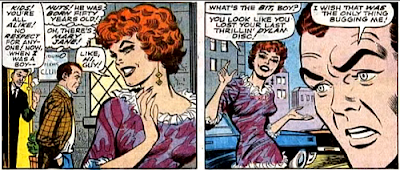(Cover from October 1968.)
"The Impossible Escape!"
Words by Stan Lee
Layouts by John Romita
Pencils by Jim Mooney
Inks by Jim Mooney
Lettering by Artie Simek
So, like a dropped ball in a football match, we kick off where we left off, with Spider-Man out cold on the ground, as a baying mob try to close in on him and remove his mask.
Happily for him, Captain George Stacy's at hand and, in conjunction with a cop, holds them off, declaring that removing his mask might be a violation of his legal rights. Gwen, meanwhile, is worried about Peter Parker, goes in search of him and, when she fails to find him?
You've guessed it, she bursts into tears. This is her third bout of sobbing in two issues. If she hadn't become such a dull character, you might think she was emotionally unstable.
Someone else who might feel like crying is Spider-Man, who regains consciousness to find himself in a prison hospital. Realising that no one's in a rush to unmask him, he decides to bide his time and stay in bed, to give himself full opportunity to recover from the bumps and bruises of last issue.
But, of course, it's never a quiet life for Aunt May's favourite nephew - because he soon discovers there's a break-out in progress. As the would-be escapees have Captain Stacy hostage, Spider-Man decides to pretend he's on their side and that he's going to lead their jail-break. Then, one by one, in the darkness he's created by sabotaging the prison's fuse box, he polishes them off till there's only one left.
He polishes him off and that's it, job done. Captain Stacy tells him he should stand trial so he can clear his name. Spidey says he can't. Captain Stacy says why not? And Spidey departs the scene, knowing that, for Aunt May's sake, he can never run the risk of his real identity coming out. Captain Stacy meanwhile, tells the authorities that Spidey helped foil the escape, and the issue's over. It's a simple tale, noticeably atypical, with no super-villains, no actual threat to Spider-Man and no real doubt that he's going to thwart the jail-break but it's all the more pleasing and memorable for that and features one of my favourite covers from a period when classic covers had become the strip's norm.
When it comes to other news, there's a scene where Mary Jane's hanging around on a street corner, looking like a hooker. What she's doing on that street corner, looking like a hooker, is never explained and I quite like the idea that she actually is a hooker, although I suspect that was a million miles from John Romita's intention. I could be wrong but I think this is her last appearance for a startlingly long time. It seems that, for some reason, at this point Lee and Romita decided to drop her from the strip, and she goes out on a sour note, insulting Harry Osborn who's too worried about his dad's increasingly erratic behaviour to bother with MJ. In retrospect, it seems that, when Harry walks away from her, leaving her alone in the darkness, it's a metaphor for the strip itself walking away from her, as though it no longer has any use for a character it's fallen out of love with.
On the art front, at last things are more or less resolved. After the artistic roundabout of the last few issues, where it seemed like anyone who was free at the time was randomly chipping in with panels, things have settled down, with Romita doing the layouts and Jim Mooney (at last credited) doing the finished pencilling and inking. The strip looks great as a result. Mooney's one of my favourite Spider-Man artists, his work giving weight and depth to Romita's somewhat 2-D style, even if he could occasionally be a little heavy-handed with the inks.





































No comments:
Post a Comment